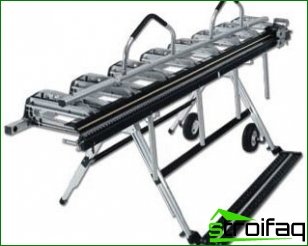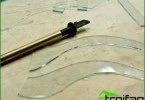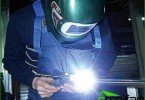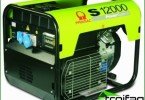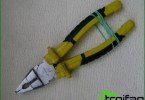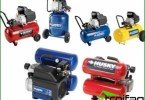To bend sheet metal in small volumes, it is not necessary to purchase industrial equipment. You can make it yourself. For the owner «with hands» such a task will not become insoluble. The main thing, making the necessary drawing, not to lose sight of the main elements.
What makes a homemade machine?
1. Roller knife. For the manufacture of such a tool should take the most durable and high-quality steel alloy. Of course, its functional resource will be used up after about 25 kilometers of processed metal (about 0.5 mm thick). However, after re-sharpening, its performance will be fully restored. The necessary procedures for this can be repeated repeatedly. If you design a steel knife with a powder bed, it will receive high resistance to the expected loads.
2. The back table. It should be such that a working metal sheet is freely placed on it. And not just accommodated, but easily moved in a given direction, conveniently refueled for work. Table supports are equipped with a cutter and a flexor.
3. The stand. To prevent parts of the manual bending machine from sliding on the floor surface, a wooden stand is used to place the desktop. It is necessary to provide for the possibility of its regulation in height. If the machine is regularly transported, its movements can be facilitated by installing wheels.
4. The front stops. Without these elements, it is not possible to set the section width correctly. The design of the stops should have the ability to rotate 180 degrees and return to its original position.
To bend sheet metal in small volumes, it is not necessary to purchase industrial equipment. You can make it yourself. For the owner «with hands» such a task will not become insoluble. The main thing, making the necessary drawing, not to lose sight of the main elements.What makes a homemade machine?
1. Roller knife. For the manufacture of such a tool should take the most durable and high-quality steel alloy. Of course, its functional resource will be used up after about 25 kilometers of processed metal (about 0.5 mm thick). However, after re-sharpening, its performance will be fully restored. The necessary procedures for this can be repeated repeatedly. If you design a steel knife with a powder bed, it will receive high resistance to the expected loads.
2. The back table. It should be such that a working metal sheet is freely placed on it. And not just accommodated, but easily moved in a given direction, conveniently refueled for work. Table supports are equipped with a cutter and a flexor.
3. The stand. To prevent parts of the manual bending machine from sliding on the floor surface, a wooden stand is used to place the desktop. It is necessary to provide for the possibility of its regulation in height. If the machine is regularly transported, its movements can be facilitated by installing wheels.
4. The front stops. Without these elements, it is not possible to set the section width correctly. The design of the stops should have the ability to rotate 180 degrees and return to its original position.
5. Measuring plate. Without it, manual bending machines will not have the necessary accuracy.
6. An emphasis of an angular bend. It is required in order to quickly install the required corner sheet. However, the bending process can be performed arbitrarily, without rigid fixation..
Work principles.
Homemade manual sheet bending machines are designed to work with aluminum, copper and sheet steel. Profile materials are made from these materials. Cut strips are used to fold a folded shelf designed to give the product extra rigidity.
The workpiece is fixed on the surface of the bending table (a clamping frame is used for this). Next, the pivot beam bends the protruding parts at the desired angle. Its maximum degree is 135. But then you can catch up to 180, such a possibility is not excluded. The maximum thickness of a metal billet is directly dependent on the power of the press mechanism.
The clamp is carried out mechanically using an eccentric screed. The clamping force is easily adjustable. Bending machines of simple design for a long time work without fail. They have long shown their reliability and relevance. They are easy to repair even in harsh conditions, including field ones. The design feature is that there is practically no limit to the length of the workpieces.
Different kinds of machines.
Bending machines can differ from each other in a certain way. There are several main features. It is possible to place an electromagnet in the body of the device, aimed at optimal workpiece clamp. Its power negates the potential slipping of the workpiece..
Designs of this type have increased rigidity. They are able to provide straightness coupled with high quality bending. In order to produce the same or similar parts, their length, as well as the bending angle itself, can be fixed or set by using special stops. In some presses, the workpieces are deformed by pressing them into a matrix recess. The pneumatic actuator provides the forces of the protrusion of the punch.
